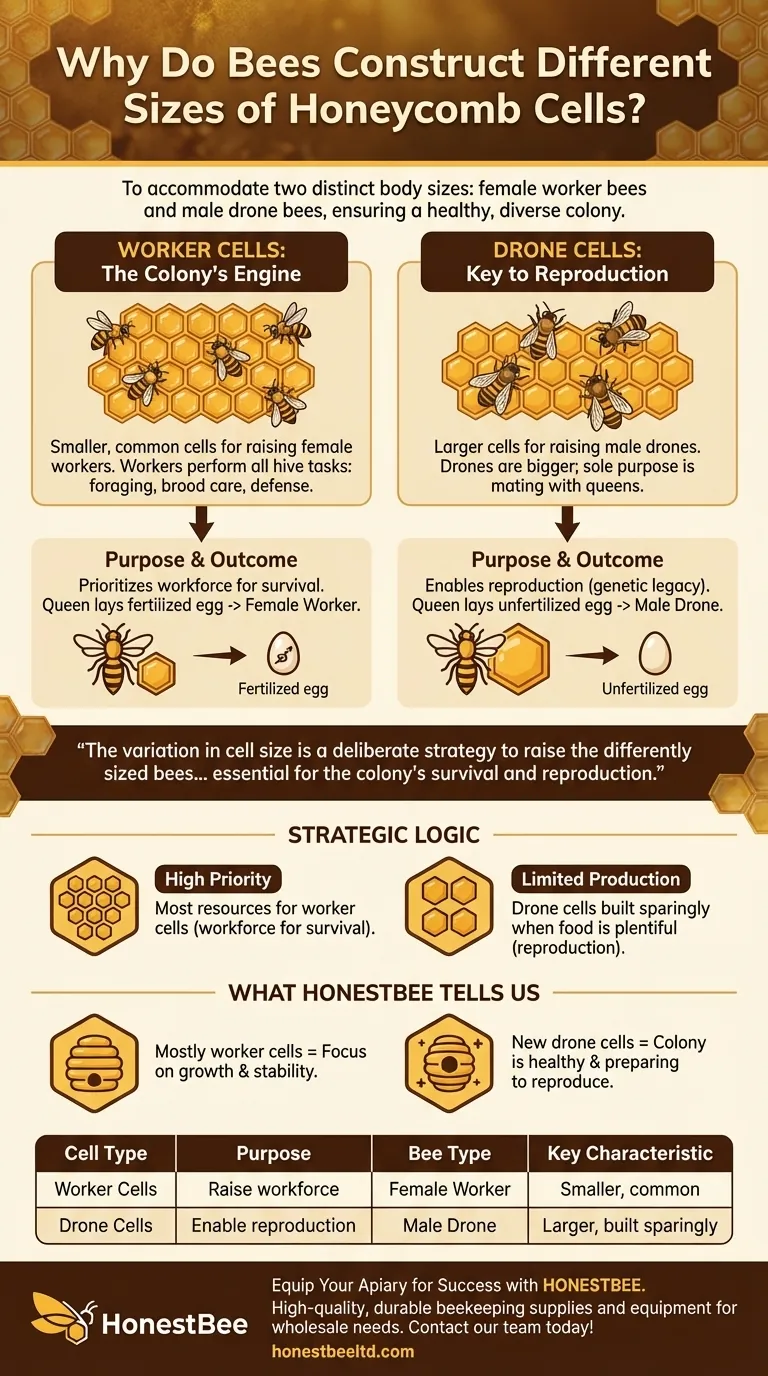In short, bees construct different-sized honeycomb cells to accommodate the two distinct body sizes of the bees they raise. The smaller, more common cells are for female worker bees, while the larger cells are built specifically for the bigger male drone bees. This architectural difference is fundamental to raising a healthy and diverse colony population.
The honeycomb is not a uniform structure; it is a carefully engineered nursery and pantry. The variation in cell size is a deliberate strategy to raise the differently sized bees—workers and drones—that are essential for the colony's survival and reproduction.

The Purpose-Built Design of a Honeycomb
A honeycomb is far more than just a storage unit for honey. It serves as the very heart of the colony: a nursery for raising young bees (brood) and a larder for storing food (honey and pollen). The physical structure of the comb is designed to meet these two critical needs efficiently.
Worker Cells: The Engine of the Colony
The vast majority of cells in any honeycomb are worker cells. These are the smaller hexagonal cells used to raise female worker bees.
Workers are responsible for nearly every task in the hive, including foraging for nectar, caring for the queen and brood, and defending the colony. Their smaller size is accommodated perfectly by these standard cells.
Drone Cells: The Key to Reproduction
Bees also construct drone cells, which are noticeably larger than worker cells. These are built to house the developing male drone bees.
Drones are physically larger and heavier than workers, so they simply cannot fit into a standard worker cell. Their sole purpose is to mate with a queen from another colony, ensuring genetic diversity.
How Cell Size Dictates the Colony's Future
The queen bee is the ultimate decision-maker. As she walks across the comb looking for empty cells to lay in, she uses her front legs to measure the cell's diameter. This measurement signals to her what kind of egg to lay.
Fertilized Eggs for a Workforce
When the queen encounters a smaller worker cell, she lays a fertilized egg. This fertilized egg will develop into a female worker bee, adding to the colony's essential labor force.
Unfertilized Eggs for Genetic Legacy
Upon finding a larger drone cell, the queen will lay an unfertilized egg. This unfertilized egg develops into a male drone bee, carrying forward the colony's genetics to future generations.
The Strategic Logic of Comb Construction
The colony does not build these cells randomly. The ratio and placement of worker-to-drone cells reflect a highly organized strategy that balances the colony's immediate needs with its long-term reproductive goals.
Prioritizing the Workforce
Because a massive workforce is needed for day-to-day survival, the colony dedicates most of its resources to building worker cells. This ensures a continuous supply of bees to gather food and manage the hive.
Limiting the Drones
Drone cells are built more sparingly. Since drones do not contribute to the daily work of the hive and consume significant resources, the colony produces them only when food is plentiful and the time is right for mating.
What Honeycomb Architecture Tells Us
By observing the types of cells being built, a beekeeper can gain insight into the colony's health, resources, and intentions.
- If your primary focus is colony health: A hive building mostly worker cells is focused on growth and resource gathering, which is a sign of a stable colony.
- If your primary focus is understanding reproduction: The appearance of new, larger drone cells indicates the colony is healthy, well-fed, and preparing to reproduce.
Ultimately, the architecture of the honeycomb is a direct reflection of the sophisticated social structure and biological needs of the honeybee colony.
Summary Table:
| Cell Type | Purpose | Bee Type | Key Characteristic |
|---|---|---|---|
| Worker Cells | Raise the colony's workforce | Female Worker Bees | Smaller, more common cells |
| Drone Cells | Enable colony reproduction | Male Drone Bees | Larger, built sparingly |
Equip Your Apiary for Success with HONESTBEE
Understanding the intricate architecture of a honeybee colony is key to successful beekeeping. Whether you manage a commercial apiary or are a beekeeping equipment distributor, having the right supplies is crucial for supporting healthy colony development.
HONESTBEE supplies high-quality, durable beekeeping supplies and equipment through our wholesale-focused operations. From foundations that encourage proper comb construction to essential hive management tools, we provide what you need to foster strong, productive colonies.
Ready to strengthen your operation? Contact our team today to discuss your wholesale needs and discover how our equipment can contribute to your success.
Visual Guide

Related Products
- Notebook Style Beeswax Foundation Mould Wax Foundation Mold
- Beeswax Foundation Sheets Beehive Foundation for Wholesale
- Electric Flatting and Embossing Machine with Tray for Beekeeping
- Food Grade Plastic bee Foundation for Bee Frames
- Electric Beeswax Flat Sheet Machine with Operating Tray for Wax Processing
People Also Ask
- What are the uses of recycled beeswax cappings? Transform Honey Byproducts into Valuable Assets
- How do bees build their honeycomb? A Marvel of Collective Engineering and Efficiency
- What is required when using wax foundation in beekeeping frames? Essential Support for Strong Combs
- What is the process for making beeswax sheets using a mold? A Step-by-Step Guide for Perfect Results
- How do you use the Foundation Mold to create beeswax foundation? Master DIY Beekeeping with Precision



















